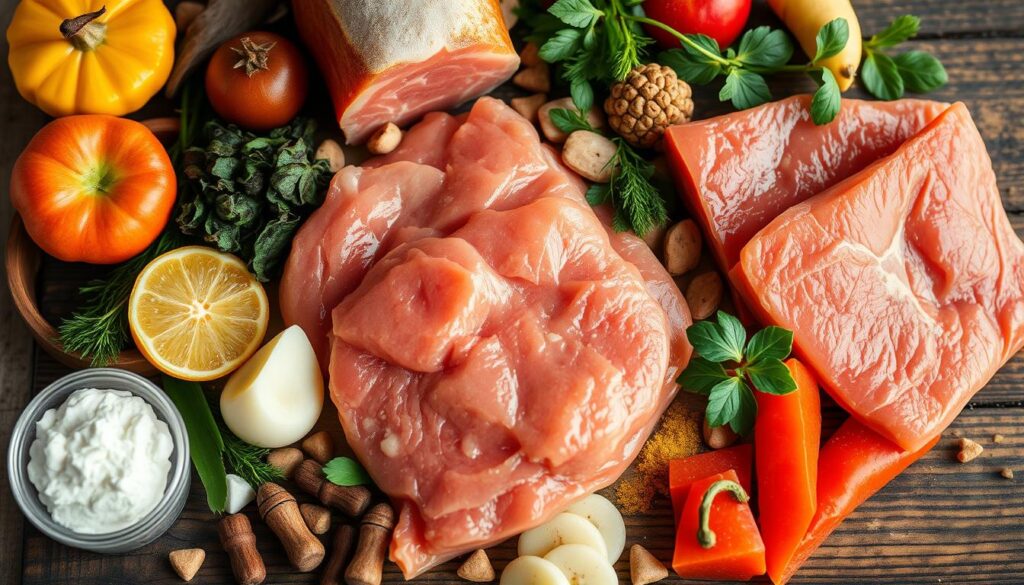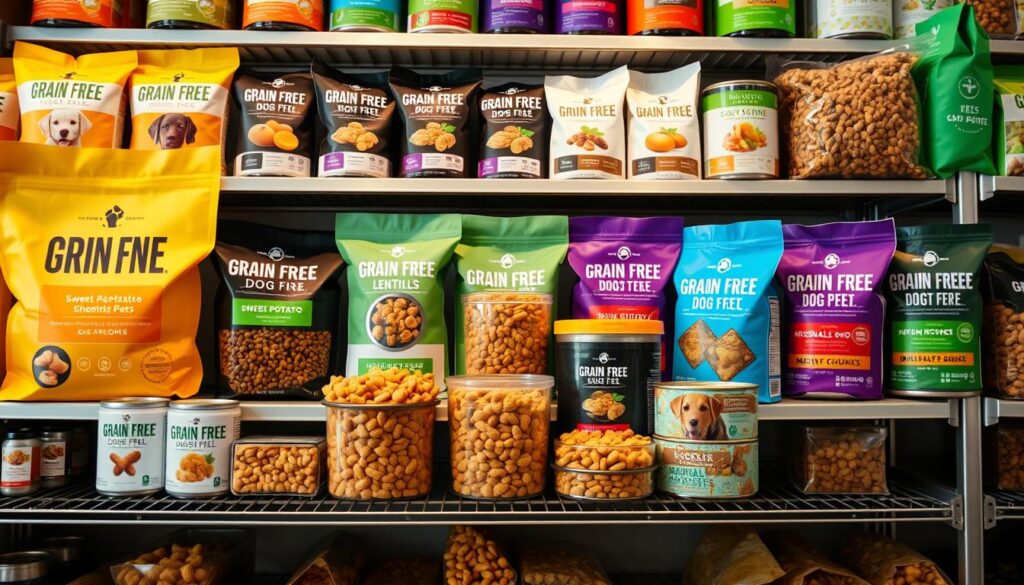As a dog owner, you might wonder if grain-free dog food is good for your pet with allergies. Grain-free dog food is getting more popular, but it’s key to know the differences. We’ll look into the good and bad of grain-free food to help you decide if it’s right for your dog.

Introduction to Grain-Free Dog Food
Grain-free dog food is a different option from regular dog food, which often has grains like corn and wheat. If your dog has allergies, finding the right food is important. Knowing about grain-free food and allergies can help you choose the best diet for your dog.
Key Takeaways
- Grain-free dog food is a popular alternative to traditional dog food
- Dog food allergies can cause a range of symptoms in dogs
- Grain-free dog food may be a good option for dogs with grain allergies
- It’s essential to understand the differences between grain-free dog food and regular dog food
- Consulting with a veterinarian can help you make an informed decision about your dog’s diet
- Grain-free dog food can provide a range of health benefits for dogs with grain allergies
Understanding Grain-Free Dog Food Basics
As a dog owner, knowing what’s in your dog’s food is key. Grain-free dog food is a good choice for dogs with grain allergies. It’s important to pick a high-quality food that fits your dog’s needs. The grain-free dog food benefits include better digestion and fewer allergy issues. Look for foods with quality grain-free dog food ingredients like chicken, salmon, or lamb.
Some common ingredients in grain-free dog food include:
- Proteins like chicken, salmon, or lamb
- Vegetables like sweet potatoes, carrots, or green beans
- Fruits like apples or blueberries
- Healthy fats like omega-3 fatty acids

For a balanced grain-free dog food, it must meet your dog’s nutritional needs. Always talk to your vet before changing your dog’s diet. By choosing a high-quality grain-free food, you ensure your dog gets the nutrients they need to stay healthy.
The Rise of Grain-Free Dog Food Trends
Have you noticed grain-free dog food becoming more popular? Many pet owners choose grain-free foods, thinking they’re better for their pets. This trend has led to new products, meeting consumer demands.
People want their dogs to eat more naturally and less processed. They think grains can cause allergies and health problems in dogs. So, the dog food market has moved towards grain-free and simple ingredient diets.
Several factors have fueled the grain-free trend:
- More focus on pet health and nutrition
- Higher interest in natural and organic products
- Improvements in pet food making and technology

In the dog food world, there’s a variety of grain-free choices. You can find everything from dry to wet food and even raw diets. It’s crucial to know the facts and science behind grain-free food. This way, you can give your dog a diet that’s healthy and fits their needs.
Identifying True Grain Allergies in Dogs
As a dog owner, it’s key to spot the signs of dog food allergies. These can show up in many ways. If you think your dog might have a grain allergy, talking to your vet is a must. They can help figure out the best way to treat it.
It’s important to know the difference between allergies and intolerances. Allergies make your dog’s immune system go haywire. Intolerances, on the other hand, are about how your dog’s body digests food. Your vet can use tests to tell them apart.
Common Symptoms of Grain Allergies
- Itching and scratching
- Skin infections and hot spots
- Ear infections
- Gastrointestinal issues, such as diarrhea and vomiting
Diagnostic Methods for Food Allergies
Your vet might suggest an elimination diet or a food trial. These tests remove common allergens, like grains, from your dog’s food. Then, they watch how your dog reacts.
Is Grain Free Dog Food Designed for Dogs with Grain Allergies?
Grain-free dog food isn’t just for dogs with grain allergies. But, it can be a good choice for them. It removes the allergen. Make sure to pick a high-quality grain-free food that fits your dog’s needs and helps with allergies.
When picking grain-free dog food, look at the ingredients and nutritional content. Choose foods with novel proteins like venison or salmon. Avoid common allergens like beef, dairy, and soy. Always talk to your vet to find the best food for your dog’s allergies.
Here are some benefits of grain-free dog food for dogs with grain allergies:
- Reduced risk of allergic reactions
- Improved digestive health
- Increased energy levels
Choosing the right grain-free dog food and working with your vet can help your dog. Always think about your dog’s nutritional needs and health. Consider getting advice from a vet or canine nutritionist for the best treatment.
The Science Behind Dog Food Allergies
Exploring dog food science is key to understanding food allergies in dogs. This knowledge helps you choose the right food for your dog and manage their allergies. Recent advances in dog food science are important to keep up with.
Proteins and grains often cause dog food allergies. But it’s not just about removing these. It’s about knowing how they affect your dog’s diet. Research shows some dogs are more likely to have allergies. It’s important to know which foods are most likely to cause them.
These foods can lead to various symptoms, from mild skin issues to serious reactions. Knowing the science behind dog food allergies helps prevent these issues. This keeps your dog healthy and happy.
Food sensitivity testing is a key tool in managing dog food allergies. It helps find out which foods cause allergies in your dog. By using this testing and the latest research, you can create a diet plan that fits your dog’s needs.
Potential Benefits and Risks of Grain-Free Diets
Thinking about switching your dog to a grain-free diet? It’s key to know the good and bad sides. Grain-free food is great for dogs with grain allergies. But, there are grain-free dog food risks to watch out for. One big worry is the link to heart disease in dogs.
For dog food safety, pick a top-notch grain-free food. Look for named proteins like chicken or salmon, and whole veggies. Stay away from fillers and by-products, as they’re hard for dogs to digest. Grain-free diets might help with digestion, reduce allergies, and boost energy.
- Nutrient deficiencies: Grain-free diets might lack fiber and vitamins.
- Increased cost: Grain-free dog food costs more than regular dog food.
- Potential link to heart disease: Some studies link grain-free diets to heart disease in dogs.
To avoid these risks, talk to your vet about a good grain-free food for your dog. With the right food and care, your dog can do well on a grain-free diet.
Alternative Options for Dogs with Food Sensitivities
Managing your dog’s food sensitivities can be tough. But, there are many alternative dog food options that can help. These options can ease symptoms and boost your dog’s health. It’s key to consider your dog’s needs and work with your vet to create a diet plan.
Trying limited ingredient diets is a good start. These diets have only one protein source and a few ingredients. This makes it easier to find out what might cause allergies. Also, hypoallergenic dog food is designed to lower allergy risks.
When picking alternative dog food, think about:
- Ingredient quality and where they come from
- If the food is balanced and complete
- The food’s manufacturing and quality checks
- Your vet’s advice and guidance
By teaming up with your vet and looking into hypoallergenic dog food, you can help your dog do well. Always put your dog’s health first. And, get professional help before changing their diet a lot.
Making the Switch to Grain-Free Food
Thinking about switching to grain-free dog food requires careful planning. A slow dog food transition helps avoid digestive issues and reduces the chance of bad reactions. Begin by adding a little of the new food to your dog’s current diet. Slowly increase the grain-free food amount over time.
This gradual change lets your dog’s stomach get used to the new food. It also helps avoid stomach problems. Keep an eye on your dog’s mood, hunger, and bowel movements during this time. These signs show how well they’re adjusting to the new diet.
- Start with a small amount of new food and gradually increase the proportion
- Monitor your dog’s behavior, appetite, and stool quality
- Be patient, as the transition process can take several days to a few weeks
By following these steps and talking to your vet, you can smoothly switch to grain-free dog food. This ensures your dog gets the nutrients they need to stay healthy and happy.
Conclusion: Making an Informed Decision About Grain-Free Dog Food
As a responsible pet owner, it’s important to think carefully about your dog’s food. This includes whether grain-free dog food is the best choice. Knowing the good and bad of grain-free diets helps you pick the best food for your dog.
Deciding on grain-free food depends on your dog’s needs and health. Talk to your vet to see if it’s right for them. They might suggest other foods like limited ingredient or hypoallergenic ones. Always choose a diet that’s balanced and nutritious for your dog’s health.
FAQ
What constitutes grain-free dog food?
Grain-free dog food doesn’t have common grains like wheat, corn, or rice. Instead, it uses potatoes, sweet potatoes, or legumes as carbs.
What are the common ingredients in grain-free dog food formulas?
These formulas often have meat, poultry, or fish as the main protein. They also include veggies, fruits, and carbs like potatoes or peas.
How does grain-free dog food differ from regular dog food?
Grain-free food lacks cereal grains. It has more protein and uses other carbs for energy and fiber.
What are the common symptoms of grain allergies in dogs?
Dogs with grain allergies might have skin issues, itchiness, or digestive problems. They could also get ear infections or have ongoing stomach issues.
How can you diagnose food allergies in dogs?
To find out if a dog has a food allergy, try an elimination diet. A vet can also do food sensitivity tests to pinpoint the allergen.
How can you distinguish between food allergies and intolerances in dogs?
Food allergies are an immune reaction, while intolerances affect digestion. A vet must diagnose to choose the right treatment.
What are the most common food allergens in dogs?
Dogs often react to proteins from beef, dairy, chicken, eggs, and soy. Wheat and corn are also common allergens.
What is the role of proteins versus grains in dog food allergies?
Both proteins and grains can cause allergies in dogs. It’s important to find out which one through testing and diagnosis.
What are the potential benefits of grain-free dog food?
Grain-free food can help dogs with grain allergies. But, it must be balanced and complete nutrition for your dog.
What are the potential risks of grain-free dog food?
Some dogs might get a heart condition called DCM from grain-free food. Always check with your vet before changing your dog’s diet.
What are some alternative options for dogs with food sensitivities?
Dogs with sensitivities can try limited ingredient diets or hypoallergenic foods. Your vet can help create a customized plan.
How can you make a smooth transition to a grain-free dog food?
Switching to grain-free food should be done slowly. Take a week or two to help your dog’s digestive system adjust.
